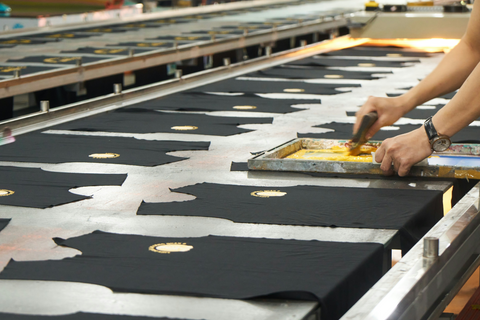The Ultimate Home Guide to Screen Printing T-Shirts
Posted by ARTEMIO NERVEZ JR

Screen printing t-shirts at home is a rewarding and creative way to express your style, promote a cause, or even start a small business. This comprehensive guide will take you through the steps to create your screen-printed t-shirts from the comfort of your home, covering everything from the materials you'll need to printing and curing your designs. Whether you're a beginner or looking to refine your skills, this guide provides valuable insights and tips to help you master the art of screen printing.
Getting Started: What You'll Need
Before diving into the printing process, it's essential to gather all the necessary materials and equipment. Here's a basic list to get you started:

- Screen and Frame: A pre-stretched screen is ideal for beginners. The mesh count (number of threads per inch) will vary depending on your design's complexity and the ink type.
- Photo Emulsion and Sensitizer: Used for creating the stencil on your screen.
- Ink: Water-based inks are recommended for beginners due to their ease of use and cleanup.
- Squeegee: A tool used to push the ink through the mesh onto the t-shirt.
- Transparency Film: For printing your design, which will be transferred to the screen.
- Exposure Unit: For exposing your screen to light to harden the emulsion around your design. A bright lamp can serve as a budget-friendly option.
- Washout Station: A setup for rinsing out the screen after exposure. This can be as simple as a sink with a hose or spray attachment.
- T-Shirts: Preferably made from 100% cotton for best results.
Step 1: Preparing Your Design
The first step is creating or choosing a design to print. When selecting a design, consider the complexity and how it will translate to screen printing. Simple, bold designs often work best. Once you have your design, print it onto a transparency film using a laser printer.
Step 2: Preparing the Screen

Coat your screen evenly with a layer of photo emulsion, then let it dry in a dark, cool place. After the emulsion is dry, place your transparency film on the screen, and expose it to light. The time required for this step varies depending on your light source and the emulsion used, so refer to the emulsion's instructions for specific timing.
Step 3: Washing Out the Screen
After exposing the screen, wash out the unexposed emulsion with water. This process reveals your stencil. Allow the screen to dry completely before moving on to printing.
Step 4: Printing Your T-Shirt

Place your t-shirt on a flat surface and position the screen on top, with the design where you want it to appear on the shirt. Pour a line of ink across the top of the screen, and then use the squeegee to pull the ink across the stencil, pressing firmly. Lift the screen carefully to reveal your design.
Step 5: Curing the Ink
The final step is to cure the ink, which ensures it sets permanently into the fabric. This can be done with a heat press, a home iron (with a piece of cloth between the iron and the design), or by placing the t-shirt in a dryer. The curing method may vary based on the ink used, so consult the ink manufacturer's recommendations.
Tips for Success
- Practice on old t-shirts or fabric scraps before printing on your final t-shirt.
- Ensure your workspace is clean and dust-free to avoid imperfections.
- Experiment with different inks and designs to find what works best for you.
- Join online communities or forums for screen printers to share tips, ask questions, and get inspired.
Screen printing t-shirts at home can be immensely satisfying, allowing for endless creativity and personalization. With patience and practice, you'll soon be creating high-quality, screen-printed t-shirts that stand out. Whether you're making a shirt for a special occasion, crafting unique gifts for friends and family, or starting your line of printed apparel, the possibilities are endless. Happy printing!
At VS Tees, the journey of screen printing t-shirts from the comfort of your home is not just rewarding but opens a world of endless creativity and customization. With some patience and practice, you'll be on your way to producing standout, high-quality screen-printed t-shirts. Whether you're designing a special shirt for an event, creating personalized gifts for loved ones, or embarking on launching your very own printed apparel brand, the opportunities are limitless.





